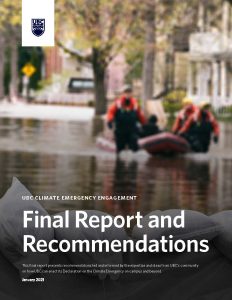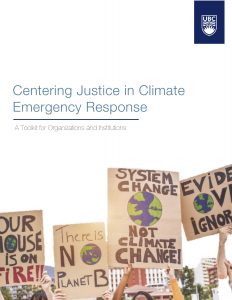UBC’s Climate Emergency is rooted in a commitment to advancing climate justice. Climate justice refers to the inequities associated with the causes, impacts, and solutions to climate change.
Causes
“Complex human vulnerability patterns are shaped by past developments, such as colonialism and its ongoing legacy (high confidence), are worsened by compounding and cascading risks (high confidence) and are socially differentiated.” IPCC Report (2022) – Technical Summary, T.S.B.7.1, p. 53.
The climate crisis is rooted in the long-standing and ongoing exploitation of the planet’s resources and the communities made vulnerable across the globe, including, but not limited to people in the Global South, Black, Indigenous, and racialized communities, and the poor or unhoused.
The degradation of our climate is a direct result of the intersecting systems of racism, colonialism, and classism that neglect to value and care for these people.
Impacts
“We basically have 3 choices: mitigation, adaptation and suffering. We’re going to do some of each. The question is what the mix is going to be. The more mitigation we do, the less adaptation will be required and the less suffering there will be.” – John Holdron, Climate Advisor to President Obama, 2007
Climate change has an amplification effect meaning that its impacts, such as extreme weather, famine, forced migration and armed conflict will exacerbate existing injustices and inequities.
As such, climate justice must be considered within today’s context of multiple intersecting crises – the pandemic, racial injustice, and massive wealth inequity – which makes certain populations increasingly vulnerable.
Solutions
“Whose voices are dominating the agenda and ‘solutions’ … There is a risk that climate justice might be (mis)appropriated as a trope unless we remain vigilant and take concrete steps towards including the voices of those who are most vulnerable to climate change impacts.” Dr. Shilpi Srivastava,
Climate solutions often threaten the same communities that are exploited by extractive industries and made vulnerable by climate impacts.
Because of power imbalances, solutions will inevitably cause further harm to people who have been made marginalized if justice is not prioritized; this will determine if climate action reduces or amplifies existing inequalities – a matter of life and death for more than a billion people.

A climate justice approach involves:
- Addressing the disproportionate impact of past and current fossil fuel extraction and climate change effects on marginalized groups
- Mitigating the impacts of current and future climate action and the energy transition on affected groups
- Assigning costs of climate mitigation, adaptation, and loss and damage to the countries and groups that have contributed to and profited most from the crisis
- Giving marginalized communities ongoing power in decision making
- Repairing the harm done to individuals and groups by undoing existing inequalities and existing systems of oppression
To learn more in-depth about climate justice and what that looks like at UBC, read:
Appendix D – Climate Justice Backgrounder from the CETF report

Centering Justice in Climate Emergency Response, A Toolkit for Organizations and Institutions

